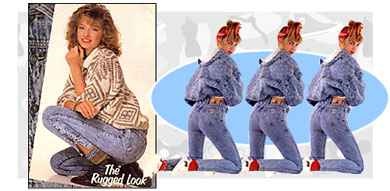Acid wash / stonewash / distressed

Fashion Synopsis
Bleach and denim were never made to mix, but the 80's were all about challenging preconceived notions and pushing the limit. Shoulders widened to astronomical proportions, Hammer pants got baggy beyond function, and bleach found a fashionable home in acid wash denim. These battle-scarred fabrics looked as if mom put too much bleach in the laundry, leaving the beloved dark indigos with pale white streaks or spots. But this was no horrible laundry mistake—acid wash was the only way to wear denim in the late 80's.
While the 70's saw surface embellishments in painting, gem studding (the Bedazzler), and fabric reconstruction, chemical distressing was an 80's invention that changed the physical state of the material. Guess?denim brought the first stonewashed jeans to America in 1982, and in 1986 a new chemical process called “acid wash” was patented by Italian Candida Laundry Company and commercialized by Rifle of Italy.
The process—also known as marble, frosted or ice wash—was a form of chemical bleaching that broke down the fibers and forced the dye to fade and bleach. Porous stones, soaked in chlorine bleach, were tumbled in humungous washers so that the repetitive beating action of the stones against the denim would bleach out the fabric unevenly and create a mottled effect.
This ‘worn-in’ look of brand new jeans caused uproars in many parents, who refused to buy brand new jeans that looked ten years old and were more expensive than the perfectly good (although dark) jeans on the next rack. (Ironically, those faded, worn jeans actually cost more to make, because of the added stonewash process). But fashion is as fickle as parents, and when a fad strikes, the followers follow. Soon, even the grown-ups were zipping into the hottest look for denim in ages.
Z. Cavaricci jeans were the biggest distributor for acid wash jeans in America, and once those streaked beauties hit the stores, the look exploded off the shelves. Denim skirts and jackets became as American as jeans, and head-to-toe denim looks became possible, thanks to acid wash prints in slouch socks, canvas sneakers and cotton hair scrunchies. The world just couldn’t get enough of acid wash denim, and once the tough old fabric broke free from stiff tradition, the relaxed look took to the extreme.
When chemicals couldn’t break down the material any further before disintegration, people furthered the distressed obsession by slicing and dicing their jeans. First it started at the knees, a simple horizontal rip to expose the kneecaps. Then the tears made their way up and down the leg, a series of slashes that shredded the jeans and offered little modesty. Hard rockers and hair metallers strutted their stuff in this ripped-up bottomwear (just check out Def Leppard’s “Pour Some Sugar On Me” video), and a generation swooned.
The most extreme (and obscene) look was that of rips across the butt, which unapologetically exposed the wearer to a chilly draft. The more modest prevented such a fashion faux pas with a sewn-in handkerchief or a pair of boxer shorts worn underneath. But most just let it all hang out.
By the time the distressed look reached its apex, anything went. Bullet holes, razor blades, scissors… the methods of destruction were continually pushed further, until one day the madness faded even more quickly than the jeans did.
Fashion Sub Categories
girl's apparelboy's apparel
trends
